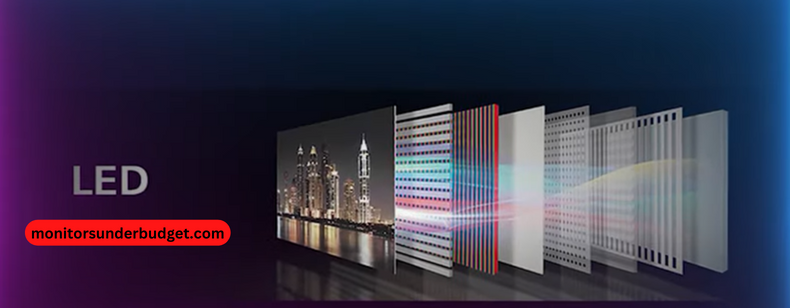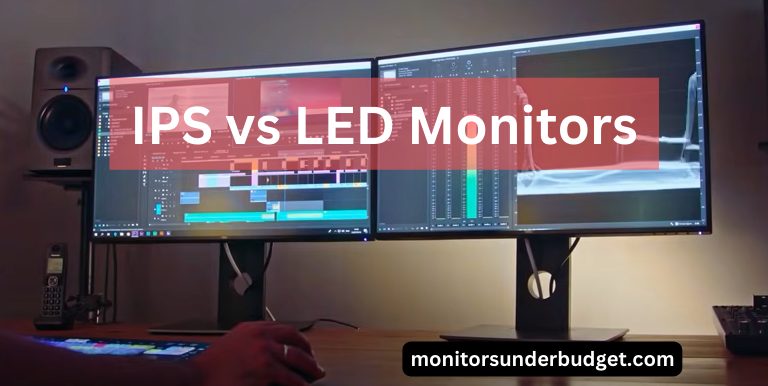The debate between IPS vs LED monitors has been long and hard-fought, with no clear winner in sight. Each technology has its advantages and disadvantages, making it difficult to choose one. In this article, we’ll take a closer look at IPS and LED monitors, their pros and cons, and help you decide which is right for you.
IPS vs LED Monitors
What is an IPS monitor- What benefits compared to other types of monitors?
An IPS monitor is an LCD computer monitor that offers several advantages over other types of monitors, such as TN or VA panels. One of the most significant benefits of IPS monitors is that they provide much wider viewing angles than different types.

You can view the screen from almost any angle without losing image quality. Additionally, IPS monitors generally offer better color reproduction and higher levels of contrast than TN or VA panels.
Finally, IPS monitors tend to be more expensive than other types of monitors, but they are often worth the extra cost for users who need the best image quality.
What are LED monitors – What benefits of IPS monitors
IPS monitors have been the standard for a long time, but LED monitors are quickly becoming a popular alternative. So, what exactly is the difference between IPS and LED? IPS stands for In-Plane Switching, referring to the technology used in LCD panels.

On the other hand, LED refers to the type of backlight used in a monitor. IPS monitors have better viewing angles and color accuracy, while LED monitors offer improved contrast and brightness levels.
One of the main benefits of LED over IPS is energy efficiency – they consume less power and produce less heat, making them more environmentally friendly.
They also tend to have slimmer designs and can provide more screen real estate in smaller sizes. Whether IPS or LED is right for you ultimately depends on your preferences and needs, but it’s worth considering the advantages LEDs offer.
The difference in price between IPS and LED monitors
When purchasing a computer monitor, many consumers are faced with the decision between IPS and LED technology. Both offer high-quality image displays, but there is a notable price difference. IPS models are more expensive due to their superior color accuracy and wider viewing angles.
On the other hand, LED monitors are often less expensive and have a slimmer design. However, they can also suffer from backlight bleeding and color inaccuracy at certain viewing angles.
Ultimately, it is up to the individual’s preference and budget when deciding between IPS and LED technology. However, those looking for consistent color accuracy at any angle may want to consider investing in an IPS model.
Which type of monitor should you buy for your specific needs?
Choosing the right monitor for your specific needs can be daunting, as there are many types and technical specifications to consider. One key aspect to consider is IPS vs LED technology.
IPS, or In-Plane Switching, monitors generally offer better color accuracy and wider viewing angles, making them a good choice for graphic designers or photographers.

LED, or Light Emitting Diode, monitors generally have faster response times and consume less power, making them a better choice for gamers or those who frequently watch action-packed movies and TV shows.
Ultimately, it all depends on your specific needs and usage habits. Additional features such as adjustable eye-care settings and touchscreen capabilities may also be worth considering.
By taking the time to carefully research and compare different options, you’ll be able to find the perfect monitor for your individual needs.
Choose the best monitor for your home or office
When purchasing a monitor for your home or office, there are a few essential factors to consider. First, think about the type of display technology you want.
IPS monitors typically have a wider viewing angle and better color reproduction, making them a popular choice for graphic designers and photographers.
On the other hand, LED monitors have lower power consumption and often come at a more affordable price point. It’s also essential to consider resolution and size.
A higher resolution means more pixels and sharper image quality. At the same time, larger sizes allow you to fit multiple windows on one screen or have a more extensive viewing area for watching movies or playing games.
Finally, don’t forget to check the monitor’s input options and make sure it will work with your computer’s ports. Overall, taking the time to research your options can help you choose the best monitor for your needs.
FAQs About IPS vs LED monitors
1. What is the difference between IPS and LED monitors?
IPS, or in-plane switching, monitors offer higher color accuracy and wider viewing angles. LED, or light-emitting diode, monitors have lower power consumption and often come at a more affordable price point.
2. What are some additional features to look for in a monitor?
Some additional features to look for include adjustable eye-care settings and touchscreen capabilities. By taking the time to carefully research and compare different options, you’ll be able to find the perfect monitor for your individual needs.
Conclusion
It is important to remember that IPS and LED monitors have benefits that make them ideal for different users. If you want a monitor with clear visuals and accurate colors, then an IPS monitor would be the better choice.
However, an LED monitor would be a better purchase if you are interested in a more affordable option with fast refresh rates. Ultimately, the decision comes down to what matters most to the individual user.
